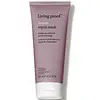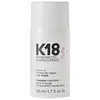What's inside
What's inside
 Key Ingredients
Key Ingredients

 Benefits
Benefits

 Concerns
Concerns

 Ingredients Side-by-side
Ingredients Side-by-side

Water
Skin ConditioningCetearyl Alcohol
EmollientTheobroma Grandiflorum Seed Butter
Skin ConditioningJojoba Esters
EmollientBehentrimonium Chloride
PreservativePPG-3 Benzyl Ether Myristate
EmollientC13-15 Alkane
SolventMeadowfoam Estolide
Skin ConditioningPolyglycerin-3
HumectantSodium Lactate
BufferingSerine
MaskingArginine
MaskingLinoleamidopropyl Dimethylamine Dimer Dilinoleate
Skin ConditioningPCA
HumectantGlycine
BufferingGuar Hydroxypropyltrimonium Chloride
Skin ConditioningEuphorbia Cerifera Wax
Alanine
MaskingValine
MaskingHelianthus Annuus Seed Wax
Skin ConditioningSodium PCA
HumectantProline
Skin ConditioningThreonine
Isoleucine
Skin ConditioningQuaternium-87
CleansingHistidine
HumectantPhenylalanine
MaskingCetyl Alcohol
EmollientCaprylyl Glycol
EmollientCetyl Hydroxyethylcellulose
Emulsion StabilisingHydroxyethylcellulose
Emulsion StabilisingCeteth-20
CleansingSteareth-20
CleansingPEG-75 Stearate
Glyceryl Stearate
EmollientParfum
MaskingGlycolic Acid
BufferingAspartic Acid
MaskingGlycerin
HumectantHydroxyacetophenone
AntioxidantEthyl Lauroyl Arginate Hcl
Skin ConditioningLimonene
PerfumingHexyl Cinnamal
PerfumingLinalool
PerfumingDipropylene Glycol
HumectantCitrus Aurantium Dulcis Peel Oil
MaskingCitrus Aurantium Bergamia Fruit Oil
MaskingLinalyl Acetate
MaskingPinene
MaskingCitronellol
PerfumingAmyl Salicylate
PerfumingEthylene Brassylate
MaskingCitrus Limon Peel Oil
MaskingTetramethyl Acetyloctahydronaphthalenes
MaskingIonone
AstringentCyclamen Aldehyde
MaskingWater, Cetearyl Alcohol, Theobroma Grandiflorum Seed Butter, Jojoba Esters, Behentrimonium Chloride, PPG-3 Benzyl Ether Myristate, C13-15 Alkane, Meadowfoam Estolide, Polyglycerin-3, Sodium Lactate, Serine, Arginine, Linoleamidopropyl Dimethylamine Dimer Dilinoleate, PCA, Glycine, Guar Hydroxypropyltrimonium Chloride, Euphorbia Cerifera Wax, Alanine, Valine, Helianthus Annuus Seed Wax, Sodium PCA, Proline, Threonine, Isoleucine, Quaternium-87, Histidine, Phenylalanine, Cetyl Alcohol, Caprylyl Glycol, Cetyl Hydroxyethylcellulose, Hydroxyethylcellulose, Ceteth-20, Steareth-20, PEG-75 Stearate, Glyceryl Stearate, Parfum, Glycolic Acid, Aspartic Acid, Glycerin, Hydroxyacetophenone, Ethyl Lauroyl Arginate Hcl, Limonene, Hexyl Cinnamal, Linalool, Dipropylene Glycol, Citrus Aurantium Dulcis Peel Oil, Citrus Aurantium Bergamia Fruit Oil, Linalyl Acetate, Pinene, Citronellol, Amyl Salicylate, Ethylene Brassylate, Citrus Limon Peel Oil, Tetramethyl Acetyloctahydronaphthalenes, Ionone, Cyclamen Aldehyde
Water
Skin ConditioningAlcohol Denat.
AntimicrobialPropylene Glycol
HumectantCetearyl Alcohol
EmollientDicaprylyl Ether
EmollientCetyl Esters
EmollientBehentrimonium Chloride
PreservativePolysorbate 20
EmulsifyingSh-Oligopeptide-78
Hydrolyzed Wheat Protein
Skin ConditioningHydrolyzed Wheat Starch
Skin ConditioningIsopropyl Alcohol
SolventTocopherol
AntioxidantPhenoxyethanol
PreservativePotassium Sorbate
PreservativeCitric Acid
BufferingParfum
MaskingGeraniol
PerfumingLinalool
PerfumingHexyl Cinnamal
PerfumingBenzyl Alcohol
PerfumingWater, Alcohol Denat., Propylene Glycol, Cetearyl Alcohol, Dicaprylyl Ether, Cetyl Esters, Behentrimonium Chloride, Polysorbate 20, Sh-Oligopeptide-78, Hydrolyzed Wheat Protein, Hydrolyzed Wheat Starch, Isopropyl Alcohol, Tocopherol, Phenoxyethanol, Potassium Sorbate, Citric Acid, Parfum, Geraniol, Linalool, Hexyl Cinnamal, Benzyl Alcohol
 Reviews
Reviews

Ingredients Explained
These ingredients are found in both products.
Ingredients higher up in an ingredient list are typically present in a larger amount.
This ingredient is a preservative and often used for it's anti-static properties. You'll most likely see this ingredient in hair conditioners.
It does not cause irritation or sensitization in leave-on products at 1-5%.
Cetearyl alcohol is a mixture of two fatty alcohols: cetyl alcohol and stearyl alcohol. It is mainly used as an emulsifier. Emulsifiers help prevent the separation of oils and products. Due to its composition, it can also be used to thicken a product or help create foam.
Cetearyl alcohol is an emollient. Emollients help soothe and hydrate the skin by trapping moisture.
Studies show Cetearyl alcohol is non-toxic and non-irritating. The FDA allows products labeled "alcohol-free" to have fatty alcohols.
This ingredient is usually derived from plant oils such as palm, vegetable, or coconut oils. There is debate on whether this ingredient will cause acne.
Due to the fatty acid base, this ingredient may not be Malassezia folliculitis safe.
Learn more about Cetearyl AlcoholHexyl Cinnamal is a fragrance ingredient with a similar scent to jasmine. It can be naturally found in chamomile essential oil.
This ingredient is a known EU allergen and may sensitize the skin. The EU requires this ingredient to be listed separately on an ingredients list.
Hexyl Cinnamal is not water soluble but is soluble in oils.
Learn more about Hexyl CinnamalLinalool is a fragrance and helps add scent to products. It's derived from common plants such as cinnamon, mint, citrus, and lavender.
Like Limonene, this ingredient oxidizes when exposed to air. Oxidized linalool can cause allergies and skin sensitivity.
This ingredient has a scent that is floral, spicy tropical, and citrus-like.
Learn more about LinaloolParfum is a catch-all term for an ingredient or more that is used to give a scent to products.
Also called "fragrance", this ingredient can be a blend of hundreds of chemicals or plant oils. This means every product with "fragrance" or "parfum" in the ingredients list is a different mixture.
For instance, Habanolide is a proprietary trade name for a specific aroma chemical. When used as a fragrance ingredient in cosmetics, most aroma chemicals fall under the broad labeling category of “FRAGRANCE” or “PARFUM” according to EU and US regulations.
The term 'parfum' or 'fragrance' is not regulated in many countries. In many cases, it is up to the brand to define this term.
For instance, many brands choose to label themselves as "fragrance-free" because they are not using synthetic fragrances. However, their products may still contain ingredients such as essential oils that are considered a fragrance by INCI standards.
One example is Calendula flower extract. Calendula is an essential oil that still imparts a scent or 'fragrance'.
Depending on the blend, the ingredients in the mixture can cause allergies and sensitivities on the skin. Some ingredients that are known EU allergens include linalool and citronellol.
Parfum can also be used to mask or cover an unpleasant scent.
The bottom line is: not all fragrances/parfum/ingredients are created equally. If you are worried about fragrances, we recommend taking a closer look at an ingredient. And of course, we always recommend speaking with a professional.
Learn more about ParfumWater. It's the most common cosmetic ingredient of all. You'll usually see it at the top of ingredient lists, meaning that it makes up the largest part of the product.
So why is it so popular? Water most often acts as a solvent - this means that it helps dissolve other ingredients into the formulation.
You'll also recognize water as that liquid we all need to stay alive. If you see this, drink a glass of water. Stay hydrated!
Learn more about Water